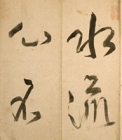Japanese Gallery (Honkan) Rooms T1 & T2
July 11, 2006 (Tue) - August 6, 2006 (Sun)
Calligraphy from the Edo period consisted of two main trends; Oieryu (the royal family style), a kind of wayo (traditional Japanese - style that developed independently since its establishment in the Heian period (794 - 1192), and karayo (Chinese style), which was modeled on the calligraphy styles of China. The Oieryu style was employed by the Tokugawa government the official calligraphic style and eventually spread to the common people through small private schools known as terakoya to become one of the most popular styles through the Edo period (1603-1868).
Conversely, Karayo enjoyed great popularity among Confucian scholars, Buddhist priests, and other intellectuals. Introduced from Ming China during the early Edo period, it rose to prominence as the esteem of Chinese culture rose with the Tokugawa government's policy to promote Confucian studies. Its basis for future popularity was born when the Karayo style was transmitted by the Chinese Zen priest Ingen Ryuki (Yin-yuan Longqi) to Dokuryu Shoeki (Duliu Xingyi) who became a priest under Ingen. Dokuryu taught the style to Kitajima Setsuzan. And Kitajima passed the style on to his student Hosoi Kotaku.
The middle Edo period saw the emergence of professional calligraphers, who made their living by teaching many students and publishing Karayo copybooks. As the tastes of Chinese intellectuals became popular among Japanese intellectuals, the Karayo calligraphy was accepted by Japanese intellectuals as part of their own culture. Their calligraphic works and poetry became a highly refined form of art and a means to express their personality and state of minds, as well as their purity and elegance.
The Karayo style spread even to the ruling class and wealthy townspeople in the late Edo period. The famous calligrapher Ichikawa Beian is said to have taught around 5000 students - including feudal lords and women.

